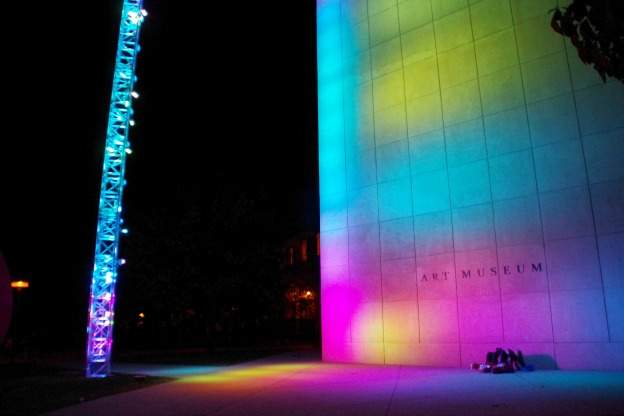
Quick: Think of the most iconic man-made structures on Earth. So, what comes to mind? The Parthenon? Machu Picchu? The Eiffel Tower? Unlike the first two, the Eiffel Tower was not built to last. The most distinguishing element of the Parisian skyline was originally conceived of as an attraction for the 1889 World's Fair. The city stipulated that the structure be easy to demolish. But when its permit expired after 20 years, the Eiffel Tower was preserved for communication purposes. Its iconicity took a while to establish, it seems.
It's hard not to hear echoes of Eiffel in the origin story of a local landmark
A Splash Of Light
"We were crazy," laughs Linda Baden, longtime Associate Director of Editorial and Marketing Services at the Indiana University Art Museum, when she remembers how the museum was planning to mark the 25th anniversary of its I.M. Pei building in 2007. "It was going to be a kind of lavish, splashy, impactful project that would go up for three months."
Light draws peoplethe bonfirewe're hardwired to be drawn to the light.
Unlike the initially unpopular Eiffel Tower however, the 70-foot-tall aluminum beacon of light created for the occasion became beloved almost immediately-
"The night before we turned it on for the public, I was tweaking it," recalls Robert Shakespeare, the artist who created Light Totem. "Somebody had seen it, and he walked across with his daughter, who was five or six years old. It was just coming to dusk, and she looked up, and she said, 'Daddy it's magic'. There was the first big clue that we might be on to a successful path."
"Light draws people," Baden asserts, "the bonfire. Â We're hardwired to be drawn to the light."
The Architectural Vision
"So here's this burst of jewel-tone color that erupts in the darker corner of the campus," Shakespeare elaborates. Â "The goal was to draw people to the art museum." Professor Emeritus of lighting design in IU's Department of Theatre and Drama, where he headed the design and technology area and its MFA lighting program, Shakespeare was selected among a national pool of light artists to implement his design for the museum's plaza.
Light Totem's subordination within an architectural program anchored by the I.M. Pei museum was implicit. So it came as something of a relief when Ted Musho, the Pei associate who oversaw the construction of the museum, gave Totem his imprimatur right away-
"Ted Musho loved it," recalls Baden. "He thought it was a perfect fulfillment of his unformed concept; that it did exactly what he hoped would happen."
"I was ecstatic with his response," Shakespeare confesses. "Here is the person who implemented I.M. Pei's vision and here I am sticking something in front of his building, that's exactly the same height, and dominates the night time sky, and I thought, 'Uh-oh, am I upstaging something?' and his answer was 'No, it's beautiful, thank you!'"
Moths To The Flame
The architect's seal of approval was just the beginning. While Shakespeare had hoped Totem would serve to promote the museum, and perhaps offer the excuse for an after-dinner stroll, his expectations were quickly exceeded-
"There have been people married in front of it," Shakespeare avers. Â "I saw a guy on his knees in front of a young woman in front of it. Â There have been choirs in front of it. There was actually a rave out there."
"So quickly did it become popular across the board," Baden asserts, "people just didn't want it to come down. Â So we thought, we'd keep it up for a while." Â The informal arrangement lasted until 2010, when the museum obtained approval from the Board of Trustees to maintain Totem as a permanent structure.
Toward A More Permanent Totem
Or so it seemeduntil the spring of 2013, at which point evening strolls around the Fine Arts Plaza became markedly less magical.
"Since it came down about a year ago," Shakespeare notes, " the constant stream of questions really spoke to me about its importance to the community."
It seems Totem still had some hurdles to jump-
When the decision was made to make Totem permanent, Baden explains, the museum agreed to annual inspections.  The 2013 inspection suggested that it would be advantageous to make certain structural changes that would allow for Totem's long-term sustainability.  With funding provided by patron Rita Grunwald and the IU Provost's Office, a more permanent iteration of Totem was engineered and installed, with the provision of inspections every ten years, instead of annually.
A Landmark That's An Experience
That sort of timetable promises that the experience of watching the southeastern face of the museum dematerialize in a sequence of what Shakespeare calls "light songs" will endure indefinitely. As will, most likely, a curious student ritual that's made many an IU bucket list. Â It's an experience Shakespeare had not anticipated
"Students discovered that when they lie on their backs and put their feet up the wallif you sort of relax, and look upsuddenly a flood of color comes rushing towards you, and it's as if you're floating on a slide of light."
When Shakespeare throws the switch around 9:30 pm, June 21, 2014Midsummer Nightthe rituals may resume. For collaborators Rob Shakespeare and Linda Baden, who are both retiring this spring after respective decades-long careers at IU, the ritual will have additional meaning. Â "It's sort of like a giant birthday candle!" the artist laughs.
Grunwald and the Provost's Office join a number of patrons who have made Light Totem possible since 2007, including Robert and Sara LeBien, Bill and Nancy Hunt, Judi and Milt Stewart, Susan Thrasher, David H. Jacobs Jr. and the DBJ Foundation, the IU Art Museum's Arc Fund, and Duke Energy.






